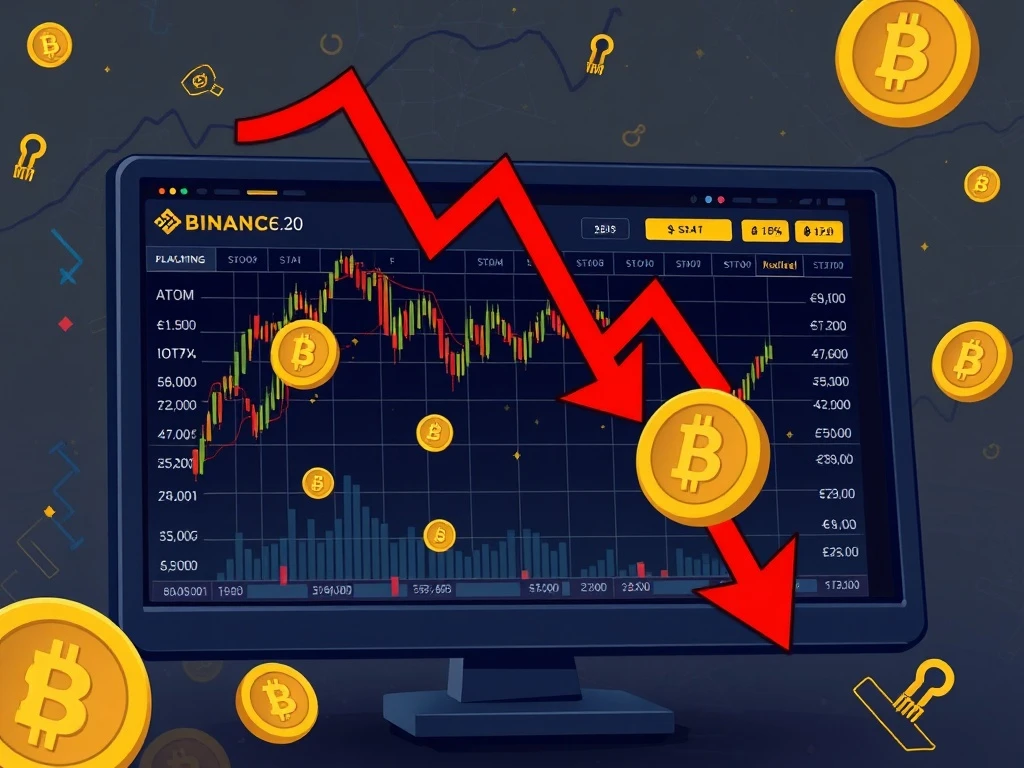Shocking Altcoin Crash: 3 Reasons Binance Saw Dramatic Zero-Price Plunges

The cryptocurrency market often experiences extreme volatility. However, a recent event on Binance sent shockwaves through the industry. Several prominent altcoins, including ATOM and IOTX, briefly crashed to near zero. This dramatic altcoin crash left many investors stunned. This article explores the reasons behind this unprecedented price drop.
Understanding the Binance Crash Anomaly
On a tumultuous Friday, the crypto market witnessed a significant downturn. While Bitcoin (BTC) saw a notable decline, altcoins on Binance experienced something far more extreme. Tokens like Cosmos (ATOM), IoTeX (IOTX), and Enjin (ENJ) briefly displayed zero-dollar valuations. This starkly contrasted their performance on other exchanges. For instance, ATOM plunged 53% elsewhere. IOTX and ENJ slipped 46% and 64.5%, respectively, on rival platforms. Crucially, none of these assets hit zero anywhere but Binance. This unique Binance crash demanded closer examination.

The total crypto market capitalization dropped by approximately $850 billion. This represented the most severe downturn since the FTX collapse. Bitcoin’s price fell from around $124,000 to $105,000. However, the altcoin sector bore the brunt of the selling pressure. This specific event highlighted a critical difference in market behavior across platforms. The localized nature of the zero-price phenomenon on Binance raised immediate questions. Many users sought answers regarding their holdings and platform stability.
The Avalanche of Crypto Liquidation
The primary driver behind the extreme price plunges was a massive wave of liquidations. Nearly $20 billion worth of crypto positions were liquidated during the Oct. 9-10 crash. This figure dwarfed the liquidations seen during the 2020 COVID-19 market rout by twentyfold. Over 1.6 million traders lost their positions. This occurred as their leveraged trades were wiped out. Many of these traders utilized leverage on Binance. They borrowed funds to amplify their potential profits. However, leverage also magnifies losses. When prices fall, borrowed funds quickly become insufficient to cover positions. This triggers automatic sell-offs.

Arthur Hayes, co-founder of BitMEX, explained the mechanism. He stated that major exchanges, including Binance, were “liquidating collateral tied to cross-margin positions.” This action intensified the sell-off. Simply put, as prices declined, Binance’s system automatically sold altcoins. These altcoins served as collateral to cover user losses. This automatic selling created immense downward pressure. It pushed prices even lower, initiating a dangerous feedback loop. This rapid sequence of events is a classic example of a crypto liquidation cascade. It highlights the inherent risks of leveraged trading in volatile markets.

The Critical Role of Market Makers
During periods of extreme volatility, the role of market makers becomes crucial. These entities provide liquidity to the market. They ensure there are always buyers and sellers available. However, during the recent Binance crash, a significant issue arose. Binance’s trading systems became overloaded. Some users reported:
- Frozen accounts
- Missed stop-losses
- Delayed trades
These operational challenges impacted market makers. Analysts suggested that firms like Wintermute withdrew funds from Binance. They did so due to these reported delays and system issues. When market makers pull back, the market loses its depth. A liquidity vacuum then develops. Consequently, buy orders disappear. This absence of buyers can lead to drastic price drops. In some instances, the system might even display a “zero” price. Such a display occurs even if the underlying asset holds value on other platforms. This scenario dramatically exacerbated the altcoin crash. It underscored the fragility of market infrastructure during peak stress. The swift withdrawal of market makers amplified the selling pressure. It left many assets without any immediate bids.
Binance’s Response to the Altcoin Crash and User Compensation
Following the widespread issues, Binance co-founder Yi He, the Chief Customer Service Officer, issued an apology. She acknowledged that “some users have encountered issues with their transactions.” This occurred amid extreme volatility and surging platform traffic. Binance CEO Richard Teng also offered his apologies. He stated, “I’m truly sorry to everyone who was impacted.” He further emphasized the company’s commitment to learning and improving. Binance pledged to compensate users. This compensation applies to verifiable losses. These losses must be directly tied to platform or system failures. However, losses from normal price fluctuations or unrealized gains are not eligible. This policy aims to address specific technical malfunctions. It does not cover general market risks. This move reflects an effort to restore user trust. It also highlights the challenges faced by exchanges during intense market events. Such events test the resilience of even the largest platforms. The compensation plan offers a partial remedy. It acknowledges the technical shortcomings that contributed to the extreme price movements during the Binance crash.
Lessons from the Altcoin Crash and Leveraged Trading Risks
The recent altcoin crash on Binance serves as a stark reminder of market dynamics. It highlights the magnified risks associated with leveraged trading. When the market experiences a rapid downturn, crypto liquidation cascades can quickly spiral out of control. This can lead to unexpected and extreme price movements. Furthermore, the event underscored the importance of robust exchange infrastructure. The stability of trading systems and the presence of market makers are vital. They ensure orderly price discovery, even during stress. A similar “flash crash” occurred in 2017. Ethereum briefly fell to $0.10 on GDAX due to a flood of automatic sell orders. These historical precedents offer valuable lessons. Investors must exercise caution. They should understand the risks of highly volatile assets. Diversifying across exchanges and avoiding excessive leverage can mitigate some dangers. This event will likely prompt exchanges to review their liquidation mechanisms. It will also encourage improvements in system resilience. Ultimately, market integrity relies on reliable infrastructure. It also depends on clear communication during crises. The altcoin crash was a challenging period for many. It provided crucial insights into market behavior.








